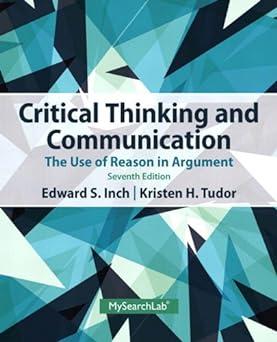1. What types of claims, evidence, and reasons were used in this discussion? Is it a boy...
Question:
1. What types of claims, evidence, and reasons were used in this discussion?
Is it a boy or a girl? How many times have soon-to-be parents been asked that question?
Historically, answers have been vague, but technological advances have made it possible for parents not only to know the sex of their unborn child but to choose it. The development of new techniques such as sperm-sorting, prenatal testing, pregnancy termination, and the implementation of genetically tested embryos ensure babies will be born the chosen sex. With genetic diagnosis, an embryo is created and analyzed in a test tube before being placed in the womb. Sperm-sorting organizes the sperm in a way that makes it more likely to fertilize the egg with the selected chromosome. Sex selection is technologically possible, but should it be done?Consider the following discussion between Gerald and Katie and note how the arguments work together to develop an extended understanding of the issues.
Gerald: The issue doesn’t seem that complicated to me. Why shouldn’t families be able to use whatever technology is available to choose and establish the kind of family they want to raise? I think choosing the sex of your child allows people to be better parents because they are raising the sex they want and are more comfortable with.
Given the choice, I would want to eliminate the possibility of having a child with a gender-specific disease. It’s an issue of choice and freedom that we should be able to practice.
Katie: When you look at sex selection in terms of only America, it seems simple. But I think we have a social responsibility as human beings to protect rights. We need to protect the rights of children and women. Looking at the situation, I think the issues of gender inequality and aborted children would become larger and unmanageable, as it is in China. Women could easily become a minority around the world. Why is that right? Why should we allow it? If we are not careful, we will end up institutionalizing a gender bias that subjugates women.
Gerald: I don’t think giving women the ability to choose the sex of their child is producing gender inequality at all. It’s giving women more control over their bodies and their families. I also think that many women will choose to have girls, thus balancing the effects of cultural values and preferences.
Katie: Maybe, but just the fact that there is a choice between genders, that one is possibly better than the other, illustrates inequality. Our society already has a hard time balancing gender inequalities as it is; I don’t think we need another source to combat.
Gerald: I don’t think choosing a sex creates inequality at all. I think it’s just an individual preference. Most people would choose a girl because they want to raise a girl, not because they think girls are better than boys. That’s beside the point. In any case, don’t you think it makes sense to develop technologies that help us reduce disease and birth defects?
Katie: O kay, but I think that sex selection might be balanced only if everyone is educated on population and gender percentages. But would that really affect their decision on what child to have? I can see some benefits if we find a way to regulate how technologies are used, but how do we regulate them? We have no control over other countries and what they choose to do. We don’t have the right to push our cultural values and laws onto other cultures. And, how far do you push the technology?
Do we start genetically engineering all of our children? This seems like a slippery slope that has the potential to end in disaster.
Gerald: Again, I see the uses of these technological advances as ways to prevent disease, mental illness, addiction problems, and other kinds of medical and social issues we face. If obesity ran in my family, I would want to take advantage of an opportunity to limit that gene from being passed to my children. Think of the decrease in obesity after generations that could occur in America?
Step by Step Answer:

Critical Thinking And Communication The Use Of Reason In Argument
ISBN: 9780205925773
7th Edition
Authors: Edward S. Inch, Kristen H. Tudor






